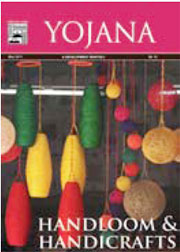(HOT) UPSC Current Affairs 2025 PDF
NEW! The Gist (NOV-2025) | E-BOOKS
(Magazine) Yojana Magazine: Issue May 2011
Yojana Magazine: Issue May 2011
There is no denying the fact that India owes a lot of its cultural identity to its rich handloom and handicrafts heritage. The colourful tapestry of bandhej, zardozi, kanjeevaram, bomkai, or tangail, the fragrance of sandalwood being carved into intricate products, the tinkle of metal as it takes awesomely varied forms under the artisan’s hammer, and the multitude of carpets and durries, boxes and bags , jewellery items and stone work may have, at some point of time in the distant past, been mere everyday activities and common place products in any typical village in any part of the country, but things are changing today. Our handloom and handicraft products are fast becoming major lifestyle statements and have secured a place for India in the lives of millions across the world. For a growing number of people at home and abroad, the exquisiteness and exclusivity of the handmade is working as a powerful lure against the monotony of the mass produced, opening up huge possibilities of market expansion. The sector provides livelihood to over 130 lakh weavers and artisans, a large percentage coming from the marginalized sections of the society. The industry is largely environment friendly and low on energy consumption, and consciousness on these issues, as also on fair trade practices is growing fast. All this makes the sector a potentially powerful player in the country’s economy and an important tool for the empowerment of crafts persons. The government, NGOs and the crafts persons themselves are today working together to work out and put into practice the best ways to unleash this potential.
There is no denying the fact that India owes a lot of its cultural identity to its rich handloom and handicrafts heritage. The colourful tapestry of bandhej, zardozi, kanjeevaram, bomkai, or tangail, the fragrance of sandalwood being carved into intricate products, the tinkle of metal as it takes awesomely varied forms under the artisan’s hammer, and the multitude of carpets and durries, boxes and bags , jewellery items and stone work may have, at some point of time in the distant past, been mere everyday activities and common place products in any typical village in any part of the country, but things are changing today. Our handloom and handicraft products are fast becoming major lifestyle statements and have secured a place for India in the lives of millions across the world. For a growing number of people at home and abroad, the exquisiteness and exclusivity of the handmade is working as a powerful lure against the monotony of the mass produced, opening up huge possibilities of market expansion. The sector provides livelihood to over 130 lakh weavers and artisans, a large percentage coming from the marginalized sections of the society. The industry is largely environment friendly and low on energy consumption, and consciousness on these issues, as also on fair trade practices is growing fast. All this makes the sector a potentially powerful player in the country’s economy and an important tool for the empowerment of crafts persons. The government, NGOs and the crafts persons themselves are today working together to work out and put into practice the best ways to unleash this potential.
Read MoreCourtesy: Yojana.gov.in


